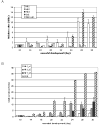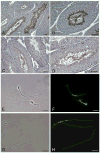Spermatogenic cell-specific type 1 hexokinase is the predominant hexokinase in sperm
- PMID: 17924400
- PMCID: PMC2412836
- DOI: 10.1002/mrd.20791
Spermatogenic cell-specific type 1 hexokinase is the predominant hexokinase in sperm
Abstract
Hexokinase is the first enzyme in the glycolytic pathway and utilizes ATP to convert glucose to glucose-6-phosphate (G6P). We previously identified three variant transcripts of Hk1 that are expressed specifically in spermatogenic cells, have different 5' untranslated regions, and encode a protein (HK1S, spermatogenic cell-specific type 1 hexokinase) in which the porin-binding domain (PBD) of HK1 is replaced by a novel N-terminal spermatogenic cell-specific region (SSR). However, the level of expression of the individual variant transcripts or of the other members of the hexokinase gene family (Hk2, Hk3, and Gck) in spermatogenic cells remains uncertain. We show that Hk1, Hk2, and Hk3 transcripts levels are quite low in spermatocytes and spermatids and Gck transcripts are relatively abundant in spermatids, but that glucokinase (GCK) is not detected in spermatozoa. Using real time RT-PCR (qPCR) with primers specific for each of the three variant forms and RNA from whole testis and isolated germ cells, we found that transcripts for Hk1_v2 and Hk1_v3, but not for Hk1_v1, are relatively high in spermatids. Similar results were seen using spermatogenic cells isolated by laser-capture microdissection (LCM). Immunoblotting studies found that HK1S is abundant in sperm, and immunostaining confirmed that HK1S is located mainly in the principal piece of the sperm flagellum, where other spermatogenic cell-specific glycolytic enzymes have been found. These results strongly suggest that HK1, HK2, HK3, and GCK are unlikely to have a role in glycolysis in sperm and that HK1S encoded by Hk1_v2 and Hk1_v3 serves this role.
(c) 2007 Wiley-Liss, Inc.
Figures






References
-
- Adams V, Griffin L, Towbin J, Gelb B, Worley K, Macabe ERB. Porin interaction with hexokinase and glycerol kinase: Metabolic microcompartmentation at the outer mitochondrial membrane. Biochem Med Metab Biol. 1991;45:271–291. - PubMed
-
- Arora KK, Fanciulli M, Pedersen PL. Glucose phosphorylation in tumor cells: Cloning, sequencing, and overexpression in active form of a full length cDNA encoding a mitochondrial bindable for hexokinase. J Biol Chem. 1990;265:6481–6488. - PubMed
-
- Beyler SA, Wheat TE, Goldberg E. Binding of antibodies against antigenic domains of murine lactate dehydrogenase-C4 to human and mouse spermatozoa. Biol Reprod. 1985;32:1201–1219. - PubMed
Publication types
MeSH terms
Substances
Associated data
- Actions
- Actions
- Actions
- Actions
- Actions
Grants and funding
LinkOut - more resources
Full Text Sources
Miscellaneous

